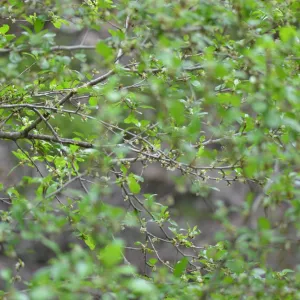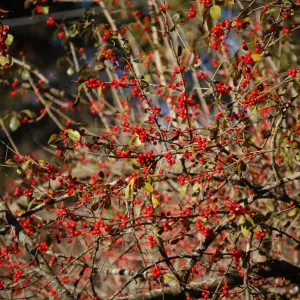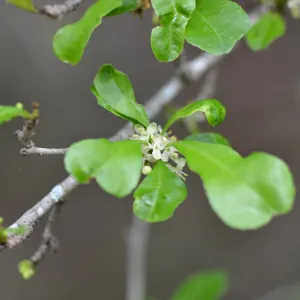By Don Fraser – Boerne Chapter, Native Plant Society of Texas
Published in the Boerne Star on December 12, 2014



What better way to start off the morning – a cup of coffee and a view that includes
a wonderful tree in your yard that provides color and attracts food for pollinators
such as bees and butterflies in the spring and berries for the birds and mammals in
the fall.
Possumhaw (Possumhaw Holly, Deciduous Holly, Deciduous Yaupon) is a small
gray-barked tree or shrub reaching heights of 15-30 feet tall with a spread of up to
15 feet with a rounded or vase shaped form. In springtime, the tree is covered with
white blooms during the March-May timeframe. The leaves remain dark green
through autumn, eventually shifting to yellow as we head into winter, and finally
dropping off completely. In the wintertime the tree is stunning in its minimalism, bare gray branches covered with small yellow to orange to red berries.
Possumhaw is native to the Southeastern US ranging from Maryland to Florida and west to Texas and Mexico. The distribution includes Zones 5 to 9 and is commonly found in fence rows in South Texas. The native habitat includes river bottoms, coastal plains and wet woods so if you have a wet area in the yard that collects
water during rainstorms you may have found an ideal spot for your new tree. Possumhaw can also be useful in stabilizing stream banks. Nevertheless, many homeowners plant possumhaw as a large accent shrub or small tree.
In an earlier NPSOT-Boerne Chapter column, Bill Ward noted that “from time to time I meet people who tell me that one needs to grow both a male and a female
possumhaw if the female plant is to produce the bright fruit. Indeed, the Manual of Vascular Plants of Texas by Correll and Johnston says Ilex has pistillate flowers (only female parts functional) and staminate flowers (only male parts functional) on separate plants. This puzzles me, because most possumhaws sold in nurseries are berry-producing plants, probably grown from cuttings. The result is that many local yards have only female possumhaws, and these plants put on berries every year, even though there is not a male plant in sight.” In our area it is very possible that you have male possumhaw plants in the area that are responsible for fertilization of your female possumhaw plants.
Possumhaw trees enjoy sun or partial shade; in full sun the female plants will have more berries and growth will be more vigorous. The plant enjoys moist soil conditions but can also thrive under fairly dry conditions.
The plant can develop many stems from the ground creating dense thickets. If you wish you can prune the multi-trunked specimens to create a tree with one central trunk. If you choose this option start pruning early in the life of the plant to achieve the form that you wish.
If you consult Google when researching possumhaw you will find recommendations from a variety of sources. Dick Bir, a retired Nursery Extension Specialist at NC State University who was recognized for his work in 2008 by the International Plant Propagators’ Society, published research in his attempt to answer the question – “Which Possumhaw is the Best?” He emphasized in bold letters – Under Our Conditions. Texas is a big state. Conditions vary from one area to another; temperature and rainfall vary from year-to-year. What grows best
in one area may not do as well in another area.
If you visit a local nursery to purchase possumhaw, call ahead to see if they sell native possumhaw plants or cultivars? If you are not sure of the difference, check the definition of cultivar in Wikipedia. Commercial nurseries that do not carry native possumhaw will likely have one of the cultivars. The Texas Chapter of the
American Society of Landscape Architects recommends the following cultivars on their website: Warren’s Red (bright red berries), Council Fire (orange berries) or Byer’s Golden (yellow berries).
Question – How do you tell a male from a female possumhaw plant in the nursery?
“It is a little like seeing a woman who is pregnant. The female possumhaw has lots of berries.” (Ernesto Carino, Medina Garden Nursery)
If you are a South Texas transplant from East Texas you may be familiar with additional varieties of possumhaw. Dr Creech (Director of the SFA Mast Arboretum) at Stephen F. Austin State University recommends Warren’s Red, Council Fire and Pocahontas but also lists a number of others. He also notes that
“softwood cuttings in June and July generally root in six to eight weeks” so if you know a friend who has a possumhaw tree that you covet, you may be able to obtain a cutting. Remember to ask first, of course. If you opt for this means of propagation, make sure to dip the cut end in rooting powder before sticking it into
moist posting soil.
There is always the option of growing possumhaw from seed, but you will likely find that they take a long time to grow and may not look anything like the parent plant.
Ernesto Carino (Medina Garden Nursery) has both male and female native possumhaw in stock. Ken Froboese (Hill Country African Violets & Nursery) has the cultivar Warren’s Red in stock. Also, be sure to attend the Annual Native Plant Sale in April 2015 where you may find native possumhaw for sale, or barter with a NPSOT member.
Possumhaw plants can grow in a variety of soil types and more detailed instructions for planting and watering possumhaw can be found on the NPSOT – Boerne webpage where it was chosen as our “Plant of the Month” in both 2002 and 2010. Follow the instructions and you will soon have a beautiful and relatively maintenance free plant that will garner positive comments from your neighbors and rave reviews from native songbirds and other wildlife as they happily dine on the berries. Be sure to plant it where you can enjoy seeing the beautiful berries that will put a smile on your face during the late fall and winter season.
Don Fraser is a member of the NPSOT and the Alamo Area Beekeepers Association. He teaches the “Honey I’ve Got The Bees” beekeeping course and is the author of a beekeeping blog at www.texmanbees.wordpress.com
